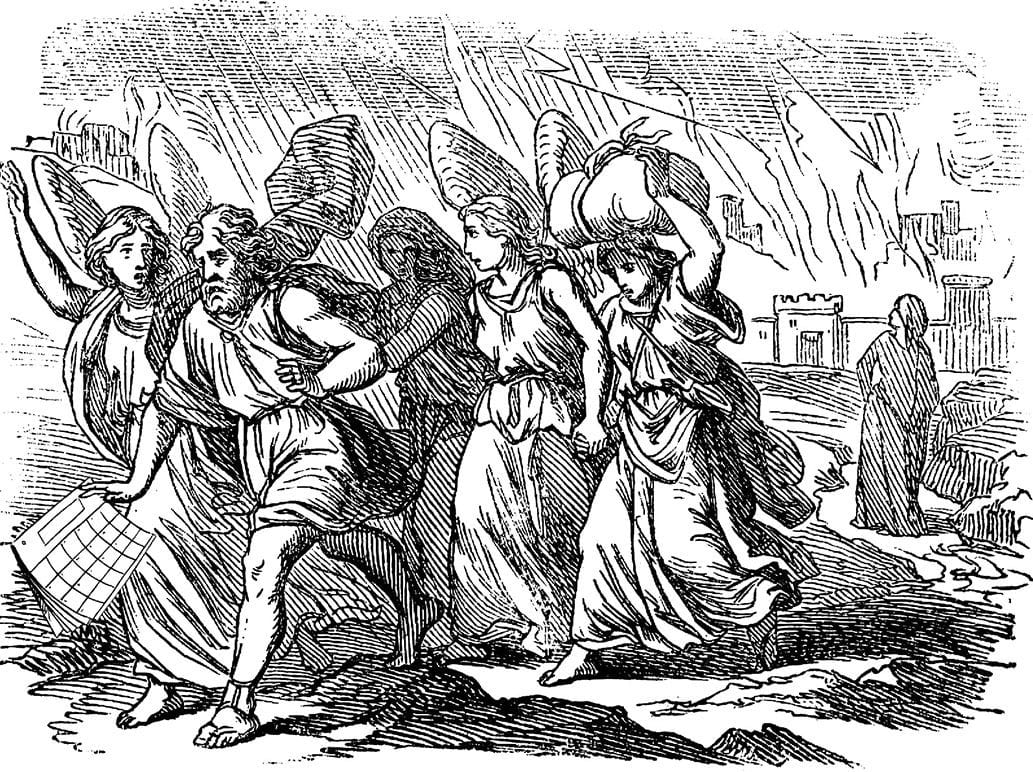Indignity Vol. 1, No. 22: Accursed timeline.
HISTORY DEP'T.

Sodom Is Not Good Enough
SOMETIME AROUND THE year 1650 B.C.E., in the place currently known as the Kingdom of Jordan, a large city suffered sudden, violent, and total destruction. According to an article in the journal Nature Scientific Reports—gathered in by the invaluable Today in Tabs Substack newsletter—a team of researchers has concluded that the site, called Tall el-Hammam today, was most likely leveled by "a cosmic airburst" that was "larger than the 1908 explosion over Tunguska, Russia, where a ~ 50-m-wide bolide detonated with ~ 1000× more energy than the Hiroshima atomic bomb."
The researchers were primarily concerned with the physical evidence at the site. Millions of mudbricks evidently disappeared from the upper layers of the city's immense, yards-thick walls and its four- or five-story palace ("It appears that most bricks were pulverized and blown off the site to the northeast"). Human bones were shattered to splinters, charred, or left in contorted positions. The whole city was covered with a "carbon-and-ash-rich destruction layer" five feet thick and replete with, among other things, "melted pottery and mudbricks; diamond-like carbon; soot; Fe- and Si-rich spherules; CaCO3 spherules from melted plaster; and melted platinum, iridium, nickel, gold, silver, zircon, chromite, and quartz." Voids in the layer appear to mark the places where rugs and tapestries were buried and then burned in place.
But the paper also nodded to a different potential source of information about what happened to Tall el-Hammam. Unlike a wayward comet or asteroid, the idea of the annihilation of a major city in the drainage plain of the Jordan River does not come to us out of nowhere. It can be found in Genesis 19:24–25:
24 Then the LORD rained upon Sodom and upon Gomorrah brimstone and fire from the LORD out of heaven;
25 And he overthrew those cities, and all the plain, and all the inhabitants of the cities, and that which grew upon the ground.
As the authors of the paper noted:
It is worth speculating that a remarkable catastrophe, such as the destruction of Tall el-Hammam by a cosmic object, may have generated an oral tradition that, after being passed down through many generations, became the source of the written story of biblical Sodom in Genesis. The description in Genesis of the destruction of an urban center in the Dead Sea area is consistent with having been an eyewitness account of a cosmic airburst, e.g., (i) stones fell from the sky; (ii) fire came down from the sky; (iii) thick smoke rose from the fires; (iv) a major city was devastated; (v) city inhabitants were killed; and (vi) area crops were destroyed.
In our secular and verifiable world, it's easy to bracket off the more dramatic events narrated in the Old Testament as existing outside the realm of conventional fact. Any educated person knows that the universe was not created in six days, that human beings evolved from other primates rather than being sculpted from the dust, that a trumpet blast will not bring down a city's walls, and so on. There may be some suggestive points—it's hard to read about the physical and social misery in the archaeological record of the Neolithic transition to agriculture without noticing how well it tracks the terms of the expulsion from Eden in Genesis 3—but what you get in Sunday school is easiest to accept as legend and metaphor, transmuted by faith. Taking it as literal history is for cranks and fanatics.
Yet here is a literal blast of fire from heaven (of some 2,000 degrees Celsius, hotter than any known kiln or Earthly conflagration at the time, the authors note, or even than volcanic magma), literally scouring a major city off the plains and strewing its crushed remains along a southwestern-to-northeastern line. (Theoretically, the authors noted, the shock wave and thermal pulse could even have been responsible for the collapsed city fortifications and burning found some 15 miles away at the site of Tell el-Sultan, "proposed as the biblical Jericho"). This would seem like a gift to the Biblical literalists trying to hold fast to the plain meaning of the Good Book's text in these godless times.
But that is a secular notion of proof. Chemical and stratigraphic evidence that a city matching the general description of Sodom suffered a celestial cataclysm approximately 3,600 years ago may sound impressive to someone who had no real conviction that Sodom existed at all. For the people who took Sodom's reality as a given, the question is whether Tall el-Hammam fits into that reality.
According to Answers Research Journal, the self-described "professional, peer-reviewed technical journal" put out by the creationist organization Answers in Genesis, it does not. Superficially attractive as Tall el-Hammam may be to certain evangelical archaeologists, it fails to properly mesh with other factual requirements laid out in the text of the Bible, as analyzed by Simon Turpin, the head of the United Kingdom branch of Answers in Genesis, in a March article.
Specifically, Turpin wrote:
In order to show why Tall el-Hammam, should not be identified as biblical Sodom, this paper proceeds by answering the following questions: (1) When was Sodom destroyed? (2) How should the lifespans of the patriarchs be understood? (3) Was Sodom inhabited again after its destruction? The answers to these three questions will show why Tall el-Hammam is not biblical Sodom.
Turpin's answers to those questions, in brief, are: 1. while Tall el-Hammam was apparently destroyed around 1650 BCE, Sodom was destroyed within the life of Abraham, who was born in 2166 BCE and died in 1991 BCE. 2. Those are the dates you get for Abraham's life by taking the ages the Bible mentions for the patriarchs as their literal lifespans, not honorific or symbolic ones, and by connecting them to the timeline of years in Exodus. And 3. the Bible says Sodom was categorically left uninhabited forever, while the Tall el-Hammam site was eventually resettled, albeit on a smaller scale.
If this ruined city was Sodom, then the timeline would be a bit under 350 years out of alignment. An ordinary empiricist might consider revising the timeline to fit the evidence of the genuine cosmic disaster. But the timeline is derived from the perfect and accurate text of the Bible, as read by the creationists. What is a five-foot-deep layer of crushed and seared fortifications and bodies, next to an already flawless divine proof of history? No, Tall el-Hammam must be a second, completely different metropolis in the neighborhood, which happened to get destroyed a few centuries after God destroyed Sodom. Maybe the space rock was copying Him.

VISUAL CONSCIOUSNESS DEP’T.
Hotel Convenience Items

More consciousness on Instagram.

REMINDER DEP’T.
THE SOPHIST is here to tell you why you're right. Send your questions to indignity@indignity.net, and get the answers you want.

SANDWICH RECIPE DEP’T.

WE PRESENT instructions for the assembly of sandwiches from Salads, Sandwiches and Chafing Dish Recipes, Copyright 1916, now in the public domain for the delectation of all, written by Marion Harris Neil, M.C.A., former Cookery Editor, The Ladies’ Home Journal, author of How to Cook in Casserole Dishes, Candies and Bonbons and How to Make Them, Canning, Preserving and Pickling, and The Something-Different Dish.
SARDINE AND TOMATO SANDWICHES
1 can sardines
2 ozs. (4 tablespoonfuls) butter
Salt
Red pepper
Buttered bread
Skinned tomatoes
Lemon-juice
Skin and bone the sardines and pound them with the butter, seasoning to taste with salt and red pepper. Spread this mixture on thin rounds of buttered bread; cut the tomatoes the same size as rounds of bread, and place a slice between two pieces, first squeezing a little lemon-juice over them. Press the rounds firmly together.
Another Method.—Skin and bone one can of sardines. Beat up one egg, add one-fourth cupful of milk and one-fourth teaspoonful of salt. Dip twelve slices of French bread in the egg mixture, and fry quickly in plenty of smoking hot fat. Place a sardine between each two slices of the fried bread, garnish with a slice of hard-cooked egg and a sprig of parsley. Serve at once.
If you decide to prepare and enjoy this sandwich, kindly send a picture to us at indignity@indignity.net.






